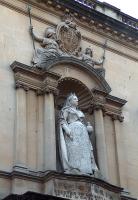
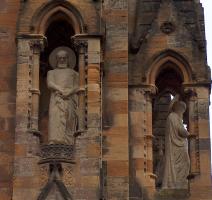
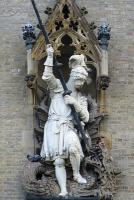
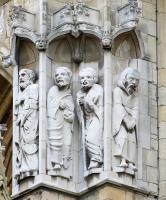
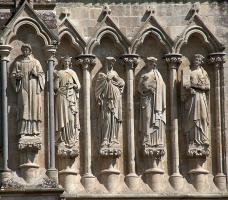
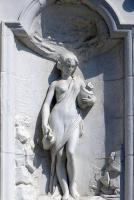
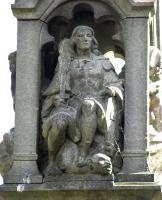
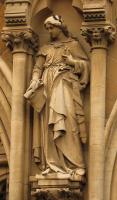
In architectural sculpture, the statue within a niche is entirely characteristic for Gothic buildings, mostly churches, and much less common for Classical buildings, mostly not churches. Gothic churches lend themselves to niches, because the strong vertical elements of the architecture readily lend themselves to have niches appended to them – lots of niches. Classical architecture takes a different approach: the niche is a distinct, separate shape in its own right: an arched niche, or a flat-topped one, with perhaps pillars to the sides and horizontal elements to the sides, to make it appear like a small gateway in its own right. Either way, the advantage of the niche is that it protects the statue from the weather, so that sculpture made of fairly soft stone can reasonably be expected to survive some hundreds of years rather than decay to unrecognisability within a generation or two, as is often the case with exposed statues. Having said this, in practice most medieval examples on the outside of the great Cathedrals, with a few important exceptions, have perished, likely more from acid rain’s effect on limestone than the wind and snow, and been replaced in the 18th, 19th or 20th Centuries, and it is these more modern statues which form the subject of this page.
I have chosen examples of niches with and without canopies, with side pillars, shallow niches and deep ones, with the statues projecting, or tucked well underneath the canopy or inside the niche. We start with the Gothic. Because of the wish to show the niche as well as the statue in each case, the figures are small, and I'd recommend clicking to enlarge to appreciate the sculpture properly.
The Gothic niche has, as we have said, vertical elements to the sides, which might be formed into Gothic pillars, with narrow clustered shafts and leafy capitals at the top. From these we can have Gothic arches springing, which may be simple or lobed, for example trefoil, with further leaves and flowers as embellishments. The arch may be in front of or surrounded by a squared-off window, or not. Or instead of a Gothic arch, we may have a canopy of greater or lesser elaboration, with the statue tucked well underneath. The statue will typically be raised up on a short pillar plinth or projecting bracket or corbel, for that is the Gothic way, and this provides a further opportunity for sculptural decoration.
Niche statues in massed ranks on Gothic cathedrals.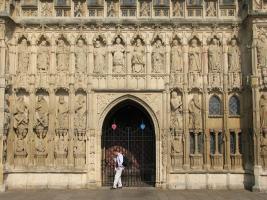
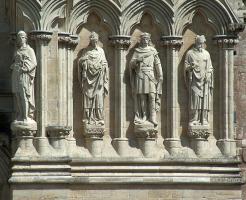
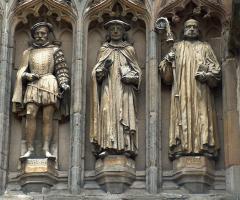
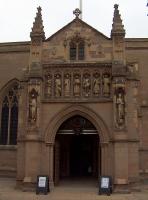
At the top end of richness, on the west front of a Cathedral we may find ranks of full-sized statues of saints in niches, as is found for example in ..... pictures. At the other end is the modest church where a single small figure is tucked within a deep niche above the porch door. Churchyard crosses, which enjoyed a renaissance in the 19th and early 20th Century as war memorials, sometimes have one or four little figures at the top within a shrine-like Gothic structure...
What about the statues themselves? Well, on a medieval Gothic building, even a new or replacement statue generally aspires to be Gothic, which at its most convincing means a tall, elongated figure wearing Medieval costume, with beard, hat or perhaps a Bishop’s mitre, holding some rod of office or a Bible, or sceptre if a kingly saint, and perhaps with one hand empty making some ecclesiastical sign, like the pictured saint on an icon. The statue will be standing, generally – sitting is perfectly acceptable but much more common inside the church than without – and as said, will be raised up on a plinth so that he will be quite high within the niche, sometimes with his head actually within the domed interior of the canopy. I say he, for our Gothic niche statues are generally male, but there are of course a few female saints, lots of Virgin Mary statues, and famous queens, including the genuinely medieval Eleanor crosses.
Gothic niches with statues of saints; the second-left picture is an Eleanor Cross.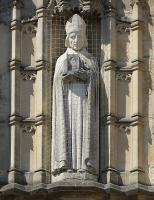
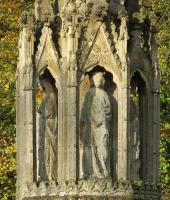
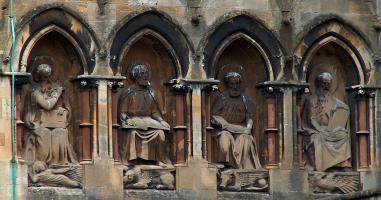
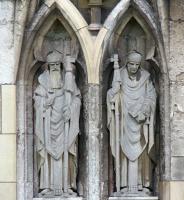
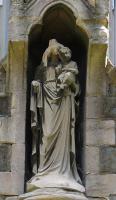
How far, then, do our statues approach this medieval ideal? Elongated faces of the Byzantine type are really rather rare, perhaps used most successfully on Catholic churches, for example Pugin’s St Chad’s Cathedral in Birmingham. But Victorian heads are far more common, with a fullness to the face, roundness to the cheek and neatness to the beard, if a beard is worn at all, which is characteristic of the 19th Century. Very skilful the sculptor’s hand may be, but there is something of the impact which the harsh, hollow lines of the uncompromisingly medieval face which is generally lost. Mitres, Crowns and strange floppy hats however are plentiful and successful. Hands – for symbolic gestures, we are mostly confined to the Catholic statues, and by far and away more common is for saints to have the objects and accoutrements associated with their stories – the keys of St Peter, the shaggy coat of St John the Baptist, the wheel of St Catherine, or to be holding staffs of office or a small building to indicate an ecclesiastic responsible for building or renewing the church. In Victorian times, it was not uncommon to have the plinth on which the statue stands labelled with their name too.
Gothic drapery on niche figures of saints, Gothic faces.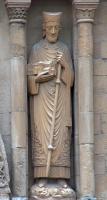
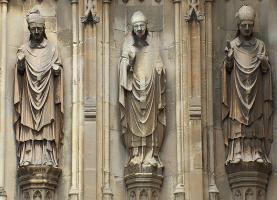
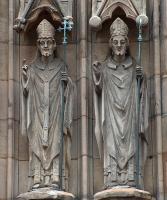
One of the most noticeable aspects of our Gothic niche statues is their clothing or drapery. For the Gothic look, the most successful treatment is a Gothic drapery, which generally consists of a long robe, often with an outer cloak, hanging vertically in many narrow, parallel folds of cloth, , or in thin, repeating curves, to give a sense of harmony and where vertical, helping to emphasise the verticality of the figure and complement the architecture. The outer garment may have wavy edges to give a more varied and elegant outline. [Wycliffe, Cath Gate Bristol, Exeter etc] A goodly number of Gothic niche statues have this sort of drapery. But many have a medieval type of garment – the robe and so on, or a tunic and robe – but with Classical Renaissance or Baroque folds. I think many of these follow Renaissance painting styles, of a Roman senator like figure, with a sheet as a garment, draped Classically around the body, or look to the Classical Baroque statues on Christopher Wren’s St Paul’s Cathedral.
Gothic niches with Classically-draped statues.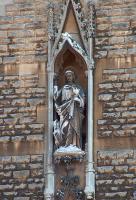
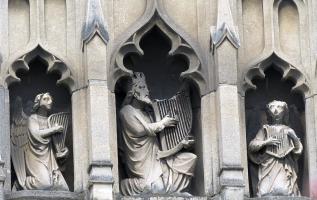
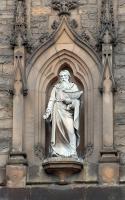
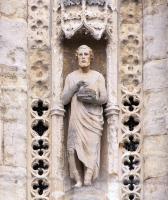
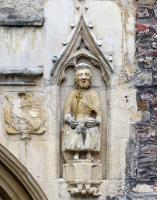
On smaller figures, the distinction is often lost because there is room for few folds, and a bit of weathering simplifies even these; often the treatment is consciously medieval in a different way, with a small, naïve figure, too squat and large headed for its height, as in the niche statue above, far right.
And kings and queens may wear the garments of their time – anything from pantaloons to togas, as may soldiers on war memorials - see picture below left. The central picture below shows King James I with a ruff, and next to him is a charming figure of St Katherine, with tightly buttoned bodice, and her Katherine wheel. To the far right, wearing only a shaggy animal skin, is a statue of St John the Baptist. All however stand in Gothic niches. Let us then make the transition to secular Gothic niche statues, as in Victorian times Gothic sprouted everywhere, and with the buildings went their statues.
Niche figures with costume: WWI soldiers, early and later kings, medieval St Katherine and ecclesiastic, and St John the Baptist in animal skin.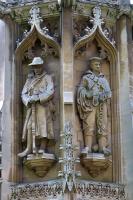
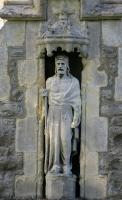
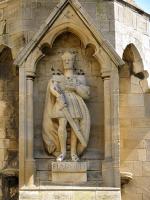
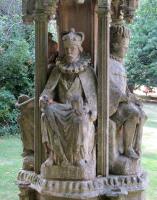
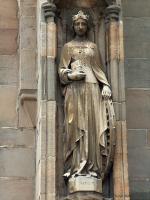
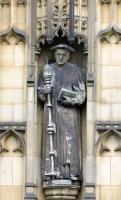
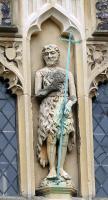
The Wills Tower in Bristol is treated much like a Cathedral with rows of figures, but as well as the kings and queens, we have allegorical girls in Classical vein – a combination carried off well enough that the mixing of the styles strikes no false note at all. The two standing girls to the right are utterly Greek, wearing chitons and see-through diaphanous robes of the type found in the nereids in the British Museum, and have muscular arms, Classical Greek noses and Greek hairstyles. They represent, in fact, the nine Muses, and their names are written on blocks underneath them, as you can see if you click to enlarge the picture.
The nine Muses, Classical figures within Gothic niches, on the Wills Tower, Bristol.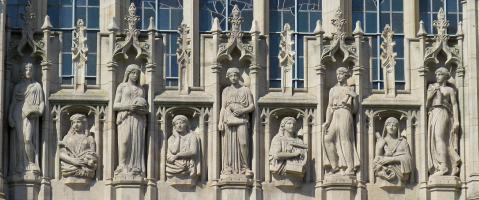
Gothic town halls, such as Bradford and Manchester, have figures of kings and queens and local heroes in the clothing and hairstyles of their time, and these are some of the most successful Victorian architectural statues - examples of both are below. I have included one example of a bust in a Gothic niche: it depicts Charles I, and is above the rear entrance porch to the church of St Margaret, Westminster. Almshouses are rich territory for statues in niches, as shown in the figure to the right of Charles I.
Secular statues in Gothic niches, including kings and queens - the bust is of Charles I.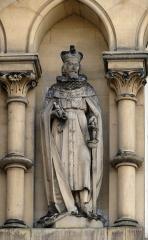
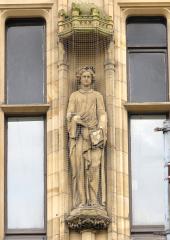
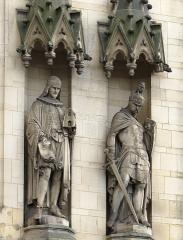
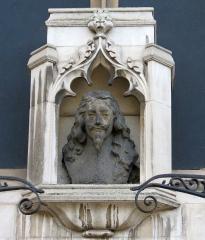
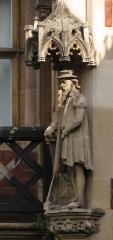
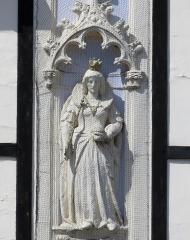
Our standard Classical niche is a round-headed deep niche popularised by John Soane, John Nash and other early 19th Century Classical architects, and picked up by the later Victorian Classicists, all the way through to Edwardian times and even later. There is often a frame to the niche, so it becomes a portico or doorway-like shape, and although the sides may be flat pillars or pilasters, more often than not these are further out to the sides and support some superstructure or pediment above the niche. A range of cool, sometimes quite austere treatments are found. Ranks of figures in Classical niches are not an obvious choice, and usually we have a single figure in a Classical niche, or a pair on either side of a central portico. If the latter, then the pair are often male and female, so there are proportionally more female Classical statues in niches than we find with the Gothic. A portrait bust is far more usual in a Classical niche than a Gothic one. A range of examples are below. Below left is a completely plain niche, and then one with a bit of ornament: side pilasters, a shell-design to the top, and a keystone. In the centre, two pillars supporting a plinth, temple-style. Then to the right, a Classical niche with a pediment, and far right, a Classical Baroque example.
Classical niche statues: examples of various types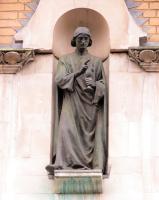
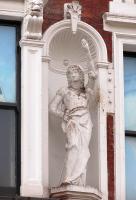
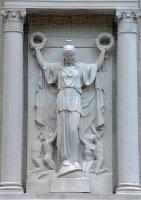
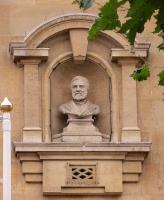
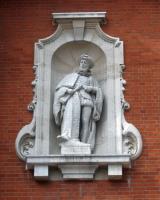
The statues are often themselves Classical, much more a correct fit for a Classical niche, and modern Victorian dress with a robe draped over it, Roman senator style, is common. Classical churches can have Classical niches, of course, and statues within them. Here are a few examples. Below left, a figure of St Luke, modern in an early 19th Century Classical niche. Then an example from inside a church - a painted Virgin Mary, Catholic of course, in St Leonard, Shoreditch. The central picture shows a pair of Charity children in niches of the Church Hall of another London church, St Botolph, Bishopsgate. Then to the right, a figure of Christ in a terra cotta Classical niche, and at the far right, another statue of the Virgin, rather sweet, somewhat more recent than the Classical niche with keystone in which she is emplaced.
Classical niches with religious statues.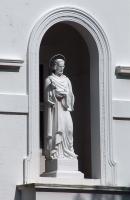
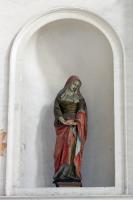
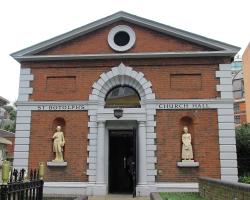
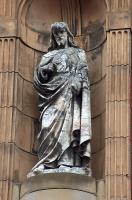
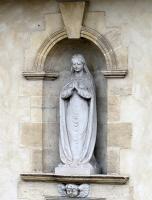
In fact such ecclesiastical examples of Classical niche sculpture are not so common. But before leaving the Churches, here is an unusual example of the reverse of the Gothic niche with a Classical sculpture, where we have a Classical niche with a Gothic statue of a saint within it.
Gothic saint within a Classical niche.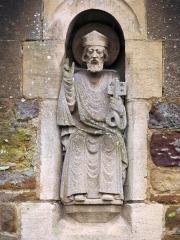
On to the secular. Victorian and Edwardian town halls are good hunting grounds for Classical niches with statues, and these will generally be of local historical worthies, and Queen Victoria too - an example with her is at the top of this page. We also have several good examples of more ancient queens, made in the 18 Century or even earlier. For purposes of recognition, our statues on town halls will usually be in the clothes of their times, so Tudor or pantalooned figures are not uncommon, somewhat of a contrast with the surrounding niche, which may be quite austere. Some examples are below, including a bust of a king in plate armour. The second one is recognisably Shakespeare, then a damaged statue in medieval costume. In the centre is a statue of John Bunyan, and next to him is a statue of Joshua Reynolds, in a Classical niche with the by-now-familiar shelly top. Next, a 17th Century king, who is Charles II, and to the far right, a gentleman in an 18th Century suit with the characteristically wide cuffs of the time.
Classical niches with historical personages, male figures.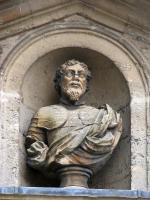
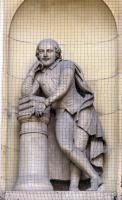
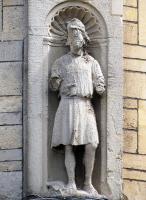
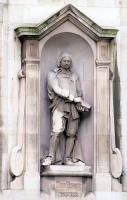
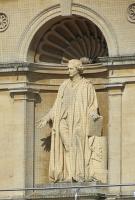
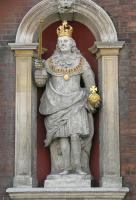

As well as historical personages, we also see allegorical Classical figure statues in niches. These may be more or less Baroque, but generally have at least some movement to the figure, and symmetry is not particularly sought after, with rather visual balance being the aim. Theatres and other entertainment venues may have Classical figures in Classical niches, here much more likely to be Baroque, and sometimes posed to look down upon the passers-by rather than the normal abstracted gaze into the middle distance. Some examples of these are below, and as the group above are all male, I have chosen this group to be female. Below from left: allegorical figure of Navigation; a semi-nude Classical girl pouring water, perhaps Venus as she stands on a shell; a figure fo Hygaea by John Bacon the Elder on the facade of Guy's Hospital in Southwark (see this page), and in the centre, two Classical girls in white glazed terra cotta, one with a book and one with a sword. Then to the right, we have an allegorical figure of Music; an allegorical girl representing Honour; and far right, one of the several figures of Prudentia found on the Prudential buildings up and down the country.
Classical niches and Classical girls, with the statues in various costumes, and
different levels of decoration of the niche.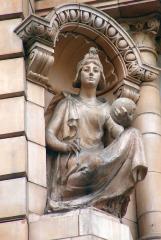
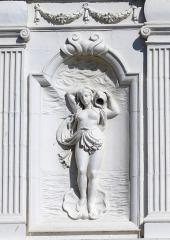
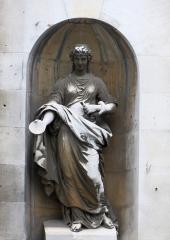
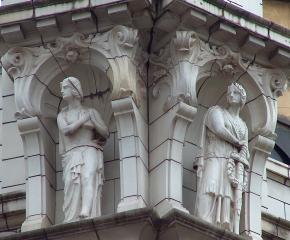
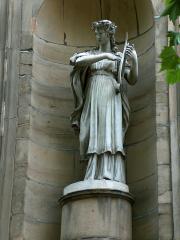
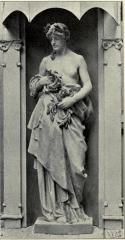
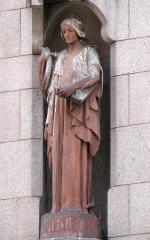
Before leaving these Classical niches, I wanted to note pots in Classical niches. They don’t really belong on this page, which is concerned with figure sculpture, but are such a common type of Victorian and Edwardian architectural sculpture that they do deserve a mention. Here are some examples of the type. The two below left are simple niches with simple pots, deriving their visual attraction from the purity of the curves. In the centre, a niche flanked by Ionic attached pillars, with a rather dumpy urn within the niche. To the right, a blocky pot with Acanthus leaf decoration in a niche with plain pilasters, and far right, a most ornate pot, almost Louis Quatorze in lightness, in a plain, masonry niche.
Architectural niches with Classical pots.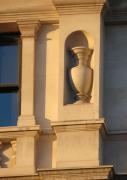
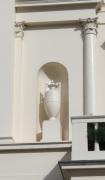
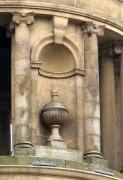
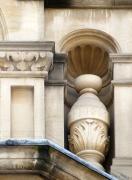
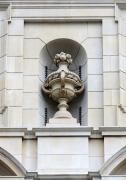
Let us end with a few less usual examples. Below left, a square niche with a Classical girl holding a lamp; a 20th Century sculpture of an ecclesiastic within a round-headed arch, again rather flat. The central picture shows Deco figures cut in relief within rectangular niches. To the right are two ceramic examples: firstly one of H.C. Fehr's queens for the Russell Hotel in London, in terra cotta, and then a glazed ceramic St George, sans dragon, in a shelly niche.
Architecture pages // Sculpture pages
Visits to this page from 25 Apr 2016: 16,766